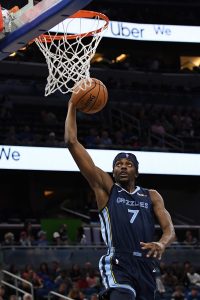The NBA salary cap is somewhat malleable, with various exceptions allowing every team to surpass the $109,140,000 threshold once their room is used up. In some cases, teams blow past not only the cap limit, but the luxury-tax limit of $132,627,000 as well — the Trail Blazers have this season’s highest payroll at the moment, more than $11MM above the tax line.
The NBA doesn’t have a “hard cap” by default, which allows a club like Portland to build a significant payroll without violating CBA rules. However, there are certain scenarios in which teams can be hard-capped.
When a club uses the bi-annual exception, acquires a player via sign-and-trade, or uses more than the taxpayer portion ($5,718,000) of the mid-level exception, that club will face a hard cap for the remainder of the league year.
When a team becomes hard-capped, it cannot exceed the “tax apron” at any point during the rest of the league year. The tax apron was set $6MM above the luxury tax line in 2017/18 (the first year of the current Collective Bargaining Agreement) and creeps up a little higher each season. For the 2019/20 league year, the tax apron – and hard cap for certain clubs – is set at $138,928,000.
More teams than ever this offseason have been willing to hard-cap themselves, and in at least a couple cases, it will significantly impact a team’s ability to add further reinforcements later in the league year. The Warriors and Heat are nearly right up against the hard cap, and won’t be players in free agency during the season unless they can shed salary.
So far this year, half the teams in the NBA have imposed a hard cap on themselves by using the bi-annual exception, using the non-taxpayer mid-level exception, or acquiring a player via sign-and-trade. Listed below are those 15 teams, along with how they created a hard cap.
Boston Celtics
- Acquired Kemba Walker from the Hornets via sign-and-trade.
Brooklyn Nets
- Acquired Kevin Durant from the Warriors via sign-and-trade.
Charlotte Hornets
- Acquired Terry Rozier from the Celtics via sign-and-trade.
Chicago Bulls
- Acquired Tomas Satoransky from the Wizards via sign-and-trade.
Dallas Mavericks
- Acquired Delon Wright from the Grizzlies via sign-and-trade.
- Used approximately $7.46MM of their mid-level exception to sign Seth Curry.
- Used their bi-annual exception to sign Boban Marjanovic.
Detroit Pistons
- Used approximately $7.32MM of their mid-level exception to sign Derrick Rose.
- Used their bi-annual exception to sign Markieff Morris.
Golden State Warriors
- Acquired D’Angelo Russell from the Nets via sign-and-trade.
Indiana Pacers
- Acquired Malcolm Brogdon from the Bucks via sign-and-trade.
Memphis Grizzlies
- Used their full mid-level exception ($9,258,000) to sign Tyus Jones.
- Used their bi-annual exception to sign Marko Guduric.
Miami Heat
- Acquired Jimmy Butler from the Sixers via sign-and-trade.
Minnesota Timberwolves
- Acquired Jake Layman from the Trail Blazers via sign-and-trade.
Orlando Magic
- Used their full mid-level exception ($9,258,000) to sign Al-Farouq Aminu.
San Antonio Spurs
- Acquired DeMarre Carroll from the Nets via sign-and-trade.
Toronto Raptors
- Used approximately $8.3MM of their mid-level exception to sign Patrick McCaw, Rondae Hollis-Jefferson, Matt Thomas, and Dewan Hernandez.
- Used their bi-annual exception to sign Stanley Johnson.
Washington Wizards
- Used approximately $7.9MM of their mid-level exception to sign Ish Smith, Admiral Schofield, and Justin Robinson.
Outside of the Warriors and Heat, no clubs on the list above are really being restricted by the hard cap at this time. A few teams – such as the Pistons and Magic – are near the luxury tax threshold, but that still gives them several million dollars in breathing room below the hard cap.
While it’s possible that trades could push some teams closer to the apron, Golden State and Miami appear to be the only clubs that will be noticeably affected by the hard cap in 2019/20.

